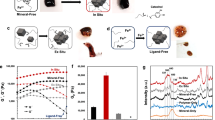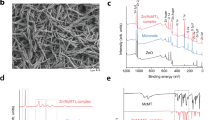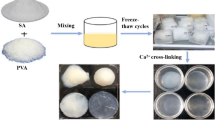Abstract
With the world’s focus on reducing our dependency on fossil-fuel energy, the scientific community can investigate new plastic materials that are much less dependent on petroleum than are conventional plastics. Given increasing environmental issues, the idea of replacing plastics with water-based gels, so-called hydrogels, seems reasonable. Here we report that water and clay (2–3 per cent by mass), when mixed with a very small proportion (<0.4 per cent by mass) of organic components, quickly form a transparent hydrogel. This material can be moulded into shape-persistent, free-standing objects owing to its exceptionally great mechanical strength, and rapidly and completely self-heals when damaged. Furthermore, it preserves biologically active proteins for catalysis. So far1 no other hydrogels, including conventional ones formed by mixing polymeric cations and anions2,3 or polysaccharides and borax4, have been reported to possess all these features. Notably, this material is formed only by non-covalent forces resulting from the specific design of a telechelic dendritic macromolecule with multiple adhesive termini for binding to clay.
This is a preview of subscription content, access via your institution
Access options
Subscribe to this journal
Receive 51 print issues and online access
$199.00 per year
only $3.90 per issue
Buy this article
- Purchase on Springer Link
- Instant access to full article PDF
Prices may be subject to local taxes which are calculated during checkout





Similar content being viewed by others
References
Hirst, A. R., Escuder, B., Miravet, J. F. & Smith, D. K. High-tech applications of self-assembling supramolecular nanostructured gel-phase materials: from regenerative medicine to electronic devices. Angew. Chem. Int. Edn 47, 8002–8018 (2008)
Marsich, E. et al. Alginate/lactose-modified chitosan hydrogels: a bioactive biomaterial for chondrocyte encapsulation. J. Biomed. Mater. Res. A 84A, 364–376 (2007)
Crompton, K. E. et al. Polylysine-functionalised thermoresponsive chitosan hydrogel for neural tissue engineering. Biomaterials 28, 441–449 (2007)
Pezron, E., Ricard, A., Lafuma, F. & Audebert, R. Reversible gel formation induced by ion complexation. 1. Borax-galactomannan interactions. Macromolecules 21, 1121–1125 (1988)
Peppas, N. A., Huang, Y., Torres-Lugo, M., Ward, J. H. & Zhang, J. Physicochemical, foundations and structural design of hydrogels in medicine and biology. Annu. Rev. Biomed. Eng. 2, 9–29 (2000)
Gong, J. P., Katsuyama, Y., Kurokawa, T. & Osada, Y. Double-network hydrogels with extremely high mechanical strength. Adv. Mater. 15, 1155–1158 (2003)
Haraguchi, K. & Takehisa, T. Nanocomposite hydrogel: a unique organic-inorganic network structure with extraordinary mechanical, optical, and swelling/de-swelling properties. Adv. Mater. 14, 1120–1124 (2002)
Liu, Y. et al. High clay content nanocomposite hydrogels with surprising mechanical strength and interesting deswelling kinetics. Polymer 47, 1–5 (2006)
Okada, A. & Usuki, A. Twenty years of polymer-clay nanocomposites. Macromol. Mater. Eng. 291, 1449–1476 (2006)
Okay, O. & Oppermann, W. Polyacrylamide-clay nanocomposite hydrogel: rheological and light scattering characterization. Macromolecules 40, 3378–3387 (2007)
Li, P., Siddaramaiah, Kim, N. H., Yoo, G. & Lee, J. Poly(acrylamide/laponite) nanocomposite hydrogels: swelling and cationic dye adsorption properties. J. Appl. Polym. Sci. 111, 1786–1798 (2009)
Sijbesma, R. P. et al. Reversible polymers formed from self-complementary monomers using quadruple hydrogen bonding. Science 278, 1601–1604 (1997)
Rockwood Additives Ltd. Laponite in Personal Care Products. Tech. Bull. L211/01g (1990)
Ihre, H., Padilla De Jesus, O. L. & Fréchet, J. M. J. Fast and convenient divergent synthesis of aliphatic ester dendrimers by anhydride coupling. J. Am. Chem. Soc. 123, 5908–5917 (2001)
Okuro, K., Kinbara, K., Tsumoto, K., Ishii, N. & Aida, T. Molecular glues carrying multiple guanidinium ion pendants via oligoether spacer: stabilization of microtubules against depolymerization. J. Am. Chem. Soc. 131, 1626–1627 (2009)
Carnahan, M. A., Middleton, C., Kim, J., Kim, T. & Grinstaff, M. W. Hybrid dendritic-linear polyester-ethers for in situ photopolymerization. J. Am. Chem. Soc. 124, 5291–5293 (2002)
Wathier, M., Jung, P. J., Carnahan, M. A., Kim, T. & Grinstaff, M. W. Dendritic macromers as in situ polymerizing biomaterials for securing cataract incisions. J. Am. Chem. Soc. 126, 12744–12745 (2004)
Nowak, A. P. et al. Rapidly recovering hydrogel scaffolds from self-assembling diblock copolypeptide amphiphiles. Nature 417, 424–428 (2002)
Yoshida, M. et al. Oligomeric electrolyte as a multifunctional gelator. J. Am. Chem. Soc. 129, 11039–11041 (2007)
Xing, B. G. et al. Hydrophobic interaction and hydrogen bonding cooperatively confer a vancomycin hydrogel: a potential candidate for biomaterials. J. Am. Chem. Soc. 124, 14846–14847 (2002)
Silva, G. A. et al. Selective differentiation of neural progenitor cells by high-epitope density nanofibers. Science 303, 1352–1355 (2004)
Sreenivasachary, N. & Lehn, J. M. Gelation-driven component selection in the generation of constitutional dynamic hydrogels based on guanine-quartet formation. Proc. Natl Acad. Sci. USA 102, 5938–5943 (2005)
Jayawarna, V. et al. Nanostructured hydrogels for three-dimensional cell culture through self-assembly of fluorenylmethoxycarbonyl-dipeptides. Adv. Mater. 18, 611–614 (2006)
Schnepp, Z. A. C., Gonzalez-McQuire, R. & Mann, S. Hybrid biocomposites based on calcium phosphate mineralization of self-assembled supramolecular hydrogels. Adv. Mater. 18, 1869–1872 (2006)
Rokita, B., Rosiak, J. M. & Ulanski, P. Ultrasound-induced cross-linking and formation of macroscopic covalent hydrogels in aqueous polymer and monomer solutions. Macromolecules 42, 3269–3274 (2009)
Dong, L., Agarwal, A. K., Beebe, D. J. & Jiang, H. R. Adaptive liquid microlenses activated by stimuli-responsive hydrogels. Nature 442, 551–554 (2006)
Ladet, S., David, L. & Domard, A. Multi-membrane hydrogels. Nature 452, 76–79 (2008)
Kiyonaka, S. et al. Semi-wet peptide/protein array using supramolecular hydrogel. Nature Mater. 3, 58–64 (2004)
Wang, Q. G., Yang, Z. M., Wang, L., Ma, M. L. & Xu, B. Molecular hydrogel-immobilized enzymes exhibit superactivity and high stability in organic solvents. Chem. Commun. 10, 1032–1034 (2007)
Das, A. K., Collins, R. & Ulijn, R. V. Exploiting enzymatic (reversed) hydrolysis in directed self-assembly of peptide nanostructures. Small 4, 279–287 (2008)
Acknowledgements
Q.W. thanks the Japan Society for the Promotion of Science postdoctoral fellowship for foreign researchers. We thank Y. Arakawa for his support for the synthesis of PEG-G3-dendron.
Author Contributions Q.W. synthesized Gn-binders and analysed the properties of hydrogels; K.O. and K.K. noticed adhesion of guanidinium-ion-appended dendrimers to glass surfaces; M.Y. assisted the rheological studies; E.L. and M.L. performed cryogenic transmission electron microscopy; and T.A., J.L.M. and Q.W. designed the study, analysed the data and wrote the paper.
Author information
Authors and Affiliations
Corresponding authors
Ethics declarations
Competing interests
The authors declare no competing financial interests.
Supplementary information
Supplementary Information
This file contains Supplementary Methods, Supplementary Synthesis of Compounds 7, 9 and 11, Binders G1, G2 and G3 and PEG-G3-dendron (25), a Supplementary Reference, Oxidation of o-Phenylenediamine with H202 Catayzed Myoglobin (Mb) and Supplementary Figures S1- S8 with Legends. (PDF 13251 kb)
Rights and permissions
About this article
Cite this article
Wang, Q., Mynar, J., Yoshida, M. et al. High-water-content mouldable hydrogels by mixing clay and a dendritic molecular binder. Nature 463, 339–343 (2010). https://doi.org/10.1038/nature08693
Received:
Accepted:
Issue Date:
DOI: https://doi.org/10.1038/nature08693
This article is cited by
-
Phantom chain simulations for fracture of polymer networks created from star polymer mixtures of different functionalities
Polymer Journal (2024)
-
Advances in emerging hydrogel fouling-release coatings for marine applications
Journal of Coatings Technology and Research (2024)
-
Design of mechanical-robust phosphorescence materials through covalent click reaction
Nature Communications (2023)
-
Exploration of a wide bandgap semiconducting supramolecular Mg(II)-metallohydrogel derived from an aliphatic amine: a robust resistive switching framework for brain-inspired computing
Scientific Reports (2023)
-
Nature-inspired micropatterns
Nature Reviews Methods Primers (2023)
Comments
By submitting a comment you agree to abide by our Terms and Community Guidelines. If you find something abusive or that does not comply with our terms or guidelines please flag it as inappropriate.



